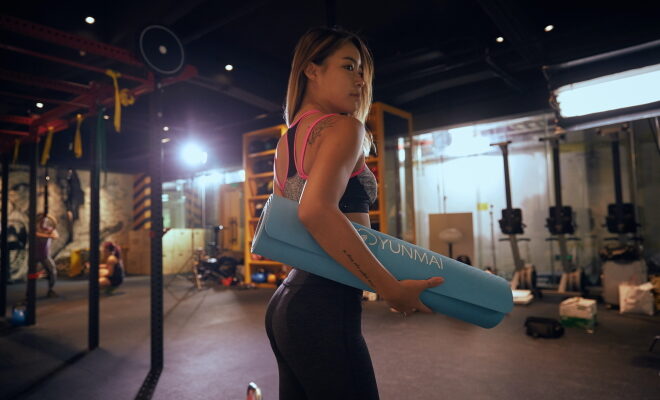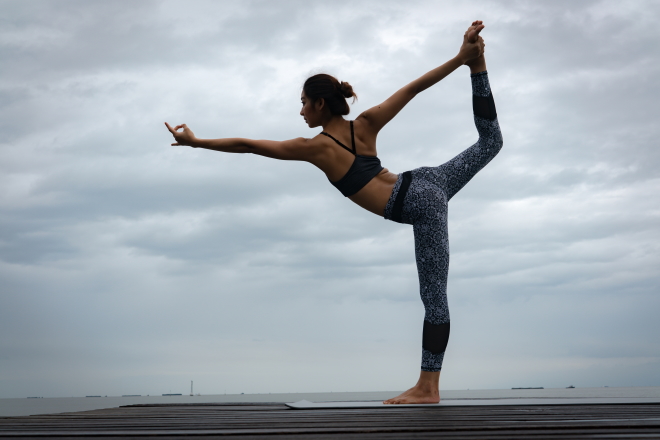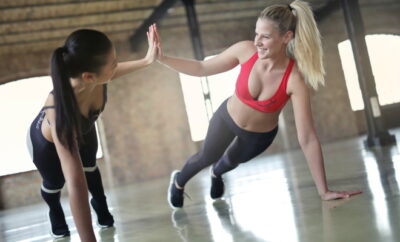
Health x Wellness
Enjoying at-home workouts in a safe manner
Many of us enjoy the flexibility, convenience and comfort that come with working out at home. We have grown accustomed to incorporating a combination of these at-home workouts into our daily schedules and home spaces. However, it can be risky for some to workout without guidance. This article shares some tips on approaching our home workouts safely.
For individuals who are less experienced or have existing injuries, at-home workouts without professional help or assistance can be physically risky. Improper form, overexertion, or using weights that are too heavy are just some of the common mistakes that can take a toll on our spine, joints, and surrounding ligaments and tendons. If these mistakes are overlooked for a prolonged period of time, graver concerns like herniated discs or osteoporosis may emerge.
So how can we spot the signs and approach at-home workouts safely, before it’s too late?
We discuss this with Dr Derrick Oh, Orthopedics and Sports Medicine, Island Orthopaedics (member of Healthway Medical).
the Active Age (AA): Have you seen an increase in workout-related injuries over the past year?
Dr. Derrick Oh (DO): Yes. Over the past six months, we have seen an uptick in workout-related injuries compared to the previous year. In particular, more patients come in with knee and ankle injuries.
This is probably due to online fitness classes and socially distanced workouts like running, gaining in popularity over the past year. Even as gyms and classes opened back up again, difficulty in booking a slot for classes, or perhaps the fear of exposure, have kept many to their self-workout routines.
In many cases, in the absence of professional help or assistance, they are prone to the dangers of overexertion, improper form, or incorrect use of equipment.
AA: Are there any new and uncommon injuries that have come about due to self-instructed workouts?
DO: Aside from the knee and ankle injuries mentioned above, there hasn’t been anything particularly uncommon.
AA: What are some common injuries that could occur when working out at home or alone?
DO: There are some popular self-workouts that have gained traction during this period, and some common injuries can surface from these workouts.
Running-related injuries: Many more people have taken up running over the past year, with most runners turning to the roads in their neighbourhoods to stay active.
However, road running can be very stressful on the knees and ankles due to hard and sometimes uneven surfaces. Having to avoid cars and bicycles will also necessitate sudden stops or change of direction. These increase the risk of ligament and meniscus damage.
Running on slopes will also increase cartilage wear under the kneecaps. This usually presents itself as pain on the front of the knee. All this pounding can also result in stress injuries to the lower limbs like the knees, shins, and ankles.
HIIT-related injuries: Another popular workout is high-intensity interval training, or HIIT. Due to the high-impact nature of some of these exercises, HIIT can place a lot of stress on your muscles, joints, tendons and ligaments. Some exercises that can cause these injuries include squats, lunges, and burpees.
Technique is vital to avoiding injury but adequate rest between sets and training days is also important. Squats are a simple exercise commonly featured in most home workouts. It should be akin to sitting down (i.e. with the butt sticking out backwards) rather than a kneeling down motion (i.e. with the knees coming forward).
Improper technique puts a lot of pressure on the meniscus, risking a tear. Poor form can cause unintended strains and activate the wrong muscle groups, but good form helps you to achieve better results with your workout.
Those who perform these exercises without proper guidance or inadequate understanding run the risk of knee injuries from poor form and overuse. The high intensity nature of the workout makes it more likely that technique will be sacrificed for expediency. Supervision is thus important to ensure good form.
Yoga-related injuries: At-home yoga became a very popular activity as well, with tons of YouTube ‘yogis’ posting classes online or physical classes going online.
For beginners, injuries across the body can happen. Even if the class is conducted live with an instructor, there are limitations to these virtual coaching sessions.
Common areas in which we see yoga-induced injuries include the hamstring, back, neck and wrists. These injuries can be sustained from traditional yoga poses such as a downward dog, forward fold, straight-arm and side planks, and back bends.
Stretching is an important part of yoga. It is essential to understand the phenomenon of Creep to execute an effective and safe stretch. Creep is a characteristic of all biological tissues. By applying a constant force across the tissue over a period of time, you will get more stretching without any increase in force. This happens because the fibres in the tissue slowly realign themselves in the direction of pull, lengthening itself in response to the constant force.
If done slowly and progressively, these stretches elongate your muscles and improve their flexibility and strength. But if you go into a stretch too quickly, or try for too much before the muscle is warmed up, there’s a risk of tearing something. When the stretch is applied too quickly, long muscles crossing multiple joints are most prone to injury. This is especially so in your hamstrings and calves.
AA: How can we prevent these injuries then?
DO: When it comes to running: Look for more cushioned and flat surfaces like running tracks in the stadium, which can be more forgiving on all your muscles and joints. It’s also very important to listen to your body. Every runner has their own speed and distance threshold. If you’re just starting out, give your body time to adapt to the increases in mileage or intensity.
Your muscles and joints also need time to recover. Repetitive use of the same muscles and joints sets you up for soreness, ennui or even injury. Give your body a day or two to rest, and adjust your running goals based on your body’s response to each run.
An alternative is cross-training. This allows you to train more frequently but as different muscle groups are used, there is an opportunity for relative rest and better holistic fitness. In general, the more different the interval exercise from your primary choice, the better. Intersperse cycling and swimming with your runs to get better results.

When practising yoga: Yogis of all levels need to follow three simple rules: warm up sufficiently, stretch slowly, and feel for your limits. Yoga may be low impact but that does not mean it’s injury-free. Our muscles work best if they are given time to gradually acclimatise to the stretches and postures that we put them through.
For beginners, don’t push yourself into unfamiliar positions too quickly. Instead, practise regularly and take gradual steps to expand your practice. Some guidance may be helpful.
Pain is usually not a good sign. Any tearing or sharp pain should prompt you to stop the pose and reassess. Forcing will almost definitely result in injury. As alignment is extremely important in yoga, try to find online classes where poses are broken down by levels so that you do not push yourself past your comfort level. Also consider checking your stance through a mirror or recording a video of your workout, which can help in avoiding injuries related to poor form.
AA: If left untreated, what are some graver complications that may arise?
DO: We have been conditioned to expect some pain or discomfort with our workouts. The old adage “No pain, no gain” is a common mantra with most dedicated athletes. This is not strictly true. Pain is there for a reason. It acts as a warning that the body’s limits are being reached or exceeded. The tricky part is understanding where your limits are and ensuring that you don’t cross over, resulting in an injury. Pains that are fleeting, dull and resolve with some rest can often be observed safely.
Rest, Ice and Elevation are simple components of the RICE therapy which can be utilised at home. Compression has been left out as too much can result in circulatory problems distal to the compression site. Any pain that is associated with mechanical symptoms should be checked out by a medical professional. This means that any joint swelling, instability or locking, signals the possibility of a serious injury. Ignoring the pain and continuing with daily workout routines can give rise to more severe issues, including:
Knee degeneration (Osteoarthritis):
- Osteoarthritis simply means a loss of cartilage in the joint. This occurs when the cartilage becomes damaged due to direct trauma or meniscal/ ligament injury. Cartilage reduces friction in your joints. The increased friction then results in pain, swelling, stiffness, and decreased mobility.
- If you’re feeling discomfort in one knee, the obvious response would be to transfer weight over to the other side. The younger and fitter you are, the longer you can afford to off-load and compensate. Unfortunately, this will result in overloading of the “good” knee. Over time, this will result in both knees suffering.
Numbness and tingling
- This can indicate possible nerve damage caused by a number of orthopaedic injuries, like a herniated disc in the neck or lower back. The area of numbness or weakness can indicate the site of damage.
- Discomfort with posture during your exercise will result in compensatory adaptations which may predispose to other injuries. Gritting your teeth and being stubborn will not suffice.
As a general rule of thumb, if your pain persists or becomes more severe over time, it’s likely that you’re dealing with an injury that requires early medical attention. In this case, you should seek the opinion of a medical professional to avoid the injury getting worse. Oftentimes, a meniscus or ligament injury can be treated and their function restored. But if neglected, they can result in cartilage damage which does not respond as easily and may result in permanent damage.
AA: How can we approach at-home workouts safely?
DO: Commit to gradual increases: Learn to walk before you run. This means to go at your own pace, and approach difficult exercises gradually and with patience. This is especially so if you are following a workout video on YouTube, which might not come with a warning label.
Self-awareness is key here: Don’t force yourself to rush or follow the pace on the videos. Instead, keep to your own speed and focus on mastering your form for every rep. Concentrate on form and then on the reps later. This will not only prevent unnecessary injuries from happening, but also make your workout more enjoyable and achievable.
Ask for help if you are unfamiliar with the workout: If you are just starting out, it’s best to consult with a certified trainer who can show you the ropes on how to perform an exercise safely. It’s also important to assess whether a workout is too difficult at your current skill or fitness level, and modify accordingly.
If it hurts, stop: Pain is a good indicator of an issue. So if you start to feel pain at any point of your workout, stop immediately.
Warm up for today, stretching for tomorrow: Always give yourself time before and after your workout routine to stretch and rest your muscles. Warmups put your muscles and joints in the best condition to start performing the workouts by loosening up your joints, and improving blood circulation. This is very important in preventing injuries.
Stretching after the workouts will lessen the pain and stiffness over the next few days. This will decrease your risk of injury and increase your ability to train.
Photo by sippakorn yamkasikorn on Unsplash









